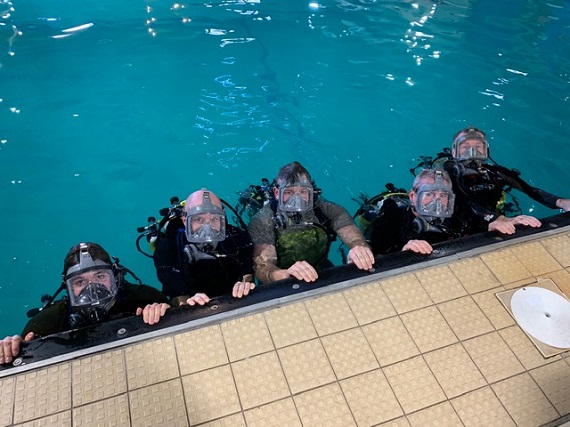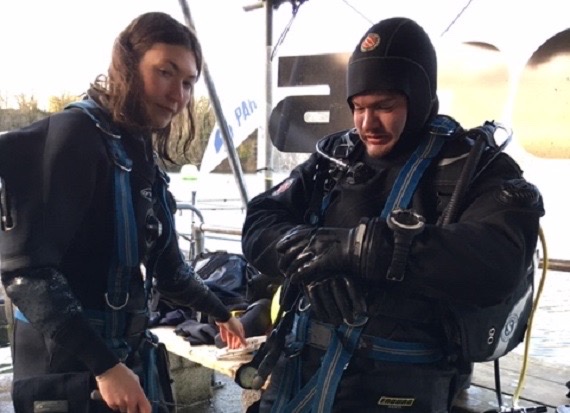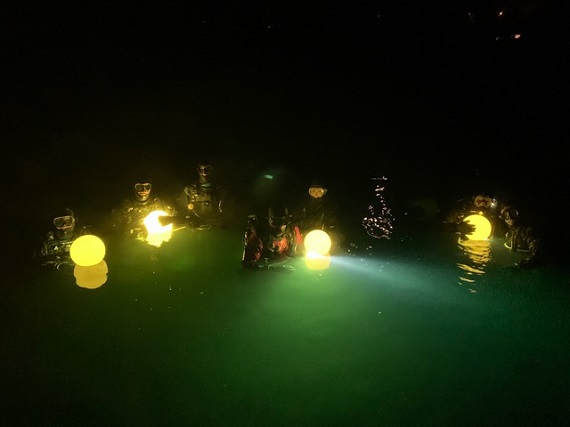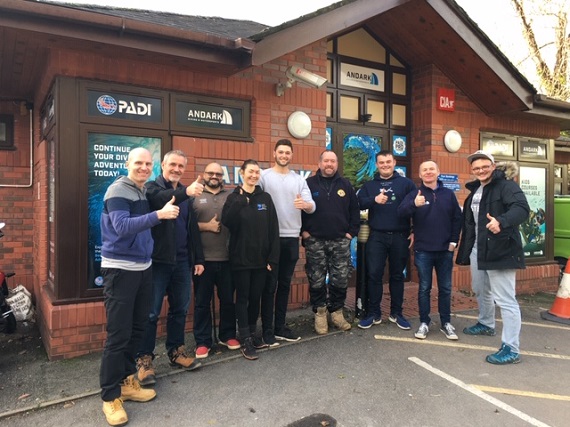Becoming an HSE Scuba commercial diver
Do you have what it takes to work underwater?
There’s a variety of agency development paths for recreational divers to follow – but what do you do if you want to get paid to dive?
In the UK, commercial divers must be approved by the Health and Safety Executive (HSE), and hold a commercial qualification appropriate for the type of work they want to do. The first rung on this ladder is called HSE Scuba (the old HSE part four) and the clue is in the title: diving with a tank on your back. Pass the course and you can call yourself a working diver.
in commercial diving, you do exactly what is asked of you
I’d long fancied taking this course so in December I booked on with Andark Diving and Watersports, which is one of only a handful of places around the UK that trains HSE divers. The course runs over two successive weeks (Monday to Friday) with a punishing schedule of diving and classroom work – necessarily so, as the course originally used to take twice as long. There were seven of us on the course, which runs three or four times each year.
The course instructor was Mike Lindsell of RS Divers, who has a long and impressive CV that stretches from inland work in Portsmouth harbour to managing divers at Rothera in Antarctica. Also teaching us was assistant instructor Rich, who is surely one of the nicest people I’ve ever met and was crucial in getting all of us up to HSE standard.
There’s a lot to cover and on day one we decamped to Vobster quarry in Somerset (approximately two hours from Andark, from where we started). First dives appeared pretty straightforward: Mike told us to descend to 15 metres, follow our guide Ben, and then be back on the surface in 20 minutes. In the post dive debrief, he asked who went to 15 metres, so I checked my computer: 13.6 metres. Not good enough, I’m told: I asked you to go to 15. Later, the group had to go and do the same dive from memory. Now, did we swim around both parts of the plane, or was it just the tail section…
This was a valuable lesson learned that in commercial diving, you do exactly what is asked of you and need supreme observational skills.
Our first was the only day we used our conventional half masks, as on the second day Mike and Rich introduced us to the Aga Interspiro, the full-face mask (FFM) that you see police and rescue divers using on the news. This is a workhorse bit of kit that crucially can house a microphone for the comms link to the surface, or other divers. Wearing an FFM feels a little strange at first, not least because it’s fastened unsparingly tightly over your head, but also as ears are cleared by pushing your nostrils onto a ‘nose block’. It’s both a novelty and reassurance being able to talk to and hear Mike and Rich ‘topside’ over the hard-wire comms, which runs alongside the diver’s lifeline. In commercial diving, the diver always has a line to the surface, whether that’s a rope to an SMB or an assistant known as a tender.
While some form of electronic communication between diver and surface is pretty much a baseline, the course mandated we learn the older system of line signals. There were several sessions up at Andark Lake, a purpose built facility (don’t call it a pond, they don’t like it) in a field behind the centre. It’s only seven metres at the deepest point which is ideal for training purposes. Through a series of ‘pulls’ (yanks) and ‘bells’ (soft tugs) the diver and tender can transmit a series of basic instructions to each other. During the course we got better at this, with the tender directing the diver to search for golf balls tossed in by Mike. You wonder how easy it would be in a less benign environment with waves, tides or currents.
Constructing objects underwater is also a key part of the course, and over two days we were challenged to first assemble a metal box and then a series of chains and shackles in the lake – the latter with a blacked-out faceplate to simulate doing it blind. To say this is difficult is an understatement, but as zero visibility is sometimes a fact for life for UK divers it’s definitely a skill worth trying to master.
The most fun day for me was on the Hamble River, where we were tasked with jumping off a boat and descending seven metres to inspect mooring lines. This is far harder than it sounds, not least as there was zero visibility on the day, plus I was struggling to fend off a head cold. By this point we were all working pretty smoothly as a team, which is an essential element to competency on the course.
The classroom sessions held back at Andark covered a range of topics, with five multiple-choice tests building up to big exam on the final day. The first paper was just basic arithmetic, but Rich was soon pummelling our grey matter with the finer points of the US Navy tables (most commonly used by commercial divers around the world), the Canadian Navy’s DCIEM tables (often preferred by diving contractors, as they’re the most liberal with their bubble modelling) and prep for the scuba diving test paper. The latter was not too arduous if you’re a relatively experienced diver. But the final exam needed some serious attention, as it’s a 50-question ‘Diving at Work’ paper that covers the legal stuff, buoyage and navigation at sea, plus a few other surprises.
I’m pleased to report that Andark’s HSE class of December 2019 all passed – myself included, and have now got that valuable first ticket into the world of working underwater. This could lead to careers as media or safety divers, scientific and research, and inland/inshore work, as well as pool and aquatic-type repairs. I’d highly recommend the HSE Scuba course as a way to improve your own skills, even if you plan to only dive for fun.
Many thanks to instructors Mike and Rich, plus Sharon and the team at Andark who supported all of us brilliantly throughout. You can read more about the HSE Scuba course with Andark here.

Diving to the Manx: Isle of Man
Mid-point of the Irish Sea offers a unique and stunning location for wildlife

To DPV, or not to DPV
Why James Neal believes a scooter is really a toy for divers who never want to grow up












